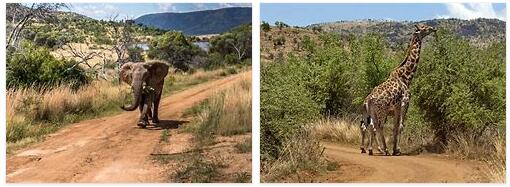
Pilanesberg National Park is located in the Northwest Province of South Africa, in the Bojanala region, west of Pretoria. This is the fourth largest park in South Africa, its area is 550 square meters. km. The park borders the Sun City entertainment complex. The park is currently managed by the Northwest Province Tourism and Parks Board.
Scattered throughout the park are various interesting objects that date back to the Iron Age and the Stone Age and show the presence of man of that period in these areas.
In 1979, Operation Genesis was launched, which was designed to strengthen the local wildlife population in the region. As part of this initiative, a 110 km fence was erected and 188 km of roads were created. Another action plan included introducing 6,000 animals into the area. In subsequent years, Operation Genesis expanded. Today, the park is home to more than 7,000 animals, 360 bird species, and more than 200 km of roads.
Information about Pilanesberg
Park area: 550 km²
Currency: South African Rand
Seasons: dry season in winter months (April to September), wet season in summer months (October to March)
- Tourist Attractions: Big Five, Hot Air Ballooning, Day Trips, Sun City
- Nearby airports: OR Tambo International (220 km)/Pilanesberg International Airport (within the park)
- Nearest cities: Johannesburg, Pretoria, Rustenburg
Just a three-hour drive from South Africa’s largest city, Johannesburg, Pilanesberg National Park offers the perfect opportunity to leave the bustle of the city behind and discover a completely different, unspoiled wilderness.
It is possible to travel by car in the park, because although most of the 200 km road is unpaved, it is still in good condition. The three main tarmac roads are called Kgabo, Kubu and Tswene.
Outside the park there are several camps serving it, such as Bagatla (Bagatla) and Manyane (Manyane). Several lodges are located in the park itself. The park offers a variety of accommodation options – there are offers for every taste. Whether you like being at one with nature in a bush safari tent or enjoying a glass of fine wine in a large bubble bath while admiring the view from the window of a luxury lodge, Pilanesberg has something for you. In addition to lodges and camps, the park has several stops where bars and souvenir shops are located.
Toward the center of the park, there is a man-made lake, the Mankwe Dam, and Mount Thabayadiotso, which means “proud mountain”. In the region of the Mankwe Dam, you can observe very beautiful scenery. This dam is the largest reservoir in the reserve, which makes it an ideal place to observe the diversity of the animal world. Waterbucks, zebras, wildebeest and impala are among the animals that make stops in the pastures bordering the dam. For bird lovers, there is a hidden spot very close to the water’s edge. Be sure to look out for screamer eagles, kingfishers and cormorants circling above the dam. All these places provide a fantastic opportunity to photograph many representatives of flora and fauna.
In Pilanesberg there are several secluded places designed specifically for photo surveillance. These places are comfortable enough to sit there in anticipation of amazing shots of representatives of the animal world. This is a rare opportunity to observe wildlife, animals and birds in their natural habitat, completely safe and out of sight.
History
Pilanesberg got its name in honor of the leader of the Tswana people, whose name sounded “Pilane”. The northern part of the Pilanesberg National Park was originally owned by the Bakgatla-Ba-Kgafela tribe (also known as the Bakgatla). The southern part used to consist of farms owned by local farmers in the 1860s and they were in charge of developing the Mankwe Dam in the reserve. These farms in the south of the park were then bought by the government in the 1960s during apartheid. The Bakubung tribe decided to settle on this land, having arrived here from the neighboring town of Ventersdorp. This land was then given to Bophuthatswana (bantustanu – territory set aside for people of a certain ethnicity; “Bophuthatswana” means a collection of Tswana people).
Then it was time for the reintroduction of the animals in the area and making the Pilanesberg a nature reserve. Chief Tsidmane Pilane of the Bakgatla tribe agreed with the inclusion of the mountainous region, which then belonged to his people, in the area of the new reserve. The families were relocated to a new town east of the reserve with the consent of the tribal authorities.
Thus, the Pilanesberg National Park was created – such as we see it today. Around the same time, Sun International secured a lease on an adjoining farm and built one of South Africa’s largest entertainment complexes, Sun City. The development of the Pilanesberg National Park is still considered one of the most complex yet ambitious projects of its kind in the world.